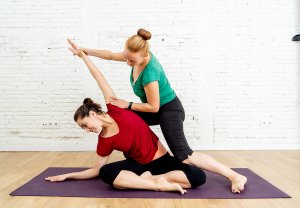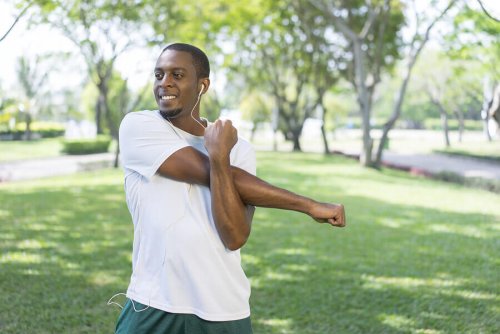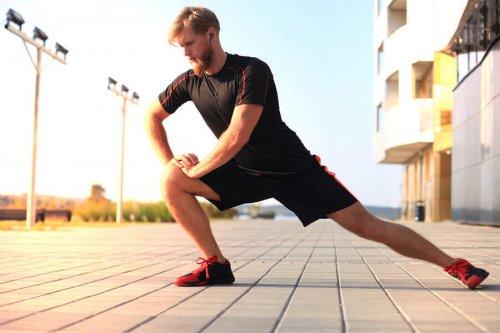What Are the Best Muscle Stretches?

There are more muscle stretches than most people imagine. You’re probably well aware of the common ones that you do before working out at the gym. Some of the more well-known stretches are shallow and don’t do much. Others, on the other hand, are really good at targeting the intended muscle groups.
No matter what type of stretch you’re doing, it’s best to understand the potential of each exercise. Each has a different objective and result. In this article, we’ll cover different types of stretches.
Static stretches: the most common muscle stretches in the gym
Static stretching is very popular in gyms. A single routine of this type of exercise can include many different muscles. Under this type of stretching, you move the joint all the way across its maximum range of movement. When you’ve done that, you keep it there for a while.
While you’re doing that, all you have to do is stay in that position for a few seconds. And don’t take the word “static” to mean that you’re not doing much of anything. In fact, movements of this type are essential for warming up and increasing your range of motion.
An example of this type of stretching is when you extend your arms completely to the side and stay in this position. Some people assert that these exercises don’t activate the stretch reflex. That is to say, you’re stretching out the muscle, but not contracting it. Yet, this continues to be a very popular way to prepare the body for exercise.
PNF Stretching
PNF stands for “proprioceptive neuromuscular facilitation.” We can say for a fact that it goes beyond just stretching out the muscles and focuses more on the contraction. This would, in theory, activate the stretch reflex. For this to happen, we don’t just lengthen the muscle, we also put pressure on it.
As you might guess then, these types of exercises demand the use of a certain amount of energy and force. Nevertheless, its proponents believe that you recover this energy expenditure 15 minutes after you stretch the muscle out. One thing we can say for sure is that these movements appear more comprehensive than the static stretches.
One example of this format is stretching the hamstrings while lying on the floor. In order to do this, a partner has to stretch your leg up to your midsection. Your partner has to stretch you out to your limit while you keep your limb stretched. A natural contraction is created on the opposite side.
Dynamic stretching: effective movements
There’s a big difference between a dynamic stretching exercise and a static one. As its name suggests, the first of these involves some sort of movement. Of course, you have to maintain control while executing these movements. That way you’ll be activating the joints without causing yourself any harm.

Many coaches, experts, and scholars think that these stretches are more efficient than static ones. Nevertheless, you have to be very careful with these. That’s because you’re going from a state of rest to a more aggressive kind of activity.
One example is when you stretch out your calf muscle by putting the ball of your foot on an elevated surface. Basically, you tend to stretch out the muscle by raising and lowering your foot. In this range of motion, we have some ballistic bouncing movement.
Muscle stretches with weights: a novel concept
Stretching with weights is a practice that’s still relatively uncommon. Nevertheless, some gym-goers prefer to incorporate weights into their stretching. Of course, you should do this gradually. For this practice, you could see the stretching sessions as having static and dynamic phases.
When you include some weight with your stretches, that generally means you’re going to be doing slow anaerobic exercise. When you reach the end of the stretch, you keep your position while supporting your weight. At this point, there’s also the static component of the movement.
If you want to try this type of stretching, you should be mindful of the movement. Start with a weight you can easily handle and increase it progressively. The good news is that you’ll be increasing your muscle mass even during this preparation phase of your workout.
Muscle stretches: which is the best?
It’s clear that stretching with static postures tends to be less taxing. Under this perspective, it seems to make sense to say that dynamic stretching is much more efficient. In events that involve a lot of running, at least, coaches seem to think so.

You can also use weights with your stretches. When you do this, you might consider it to be your warm-up. You might also be working toward muscular development aside from the regular benefits.
In conclusion, all sorts of stretching exercises have their pros and cons. For example, static versions are better and sufficient for people who are about to do more strenuous exercise or sports activities. Ultimately, the most important thing is to keep on stretching those muscles.
There are more muscle stretches than most people imagine. You’re probably well aware of the common ones that you do before working out at the gym. Some of the more well-known stretches are shallow and don’t do much. Others, on the other hand, are really good at targeting the intended muscle groups.
No matter what type of stretch you’re doing, it’s best to understand the potential of each exercise. Each has a different objective and result. In this article, we’ll cover different types of stretches.
Static stretches: the most common muscle stretches in the gym
Static stretching is very popular in gyms. A single routine of this type of exercise can include many different muscles. Under this type of stretching, you move the joint all the way across its maximum range of movement. When you’ve done that, you keep it there for a while.
While you’re doing that, all you have to do is stay in that position for a few seconds. And don’t take the word “static” to mean that you’re not doing much of anything. In fact, movements of this type are essential for warming up and increasing your range of motion.
An example of this type of stretching is when you extend your arms completely to the side and stay in this position. Some people assert that these exercises don’t activate the stretch reflex. That is to say, you’re stretching out the muscle, but not contracting it. Yet, this continues to be a very popular way to prepare the body for exercise.
PNF Stretching
PNF stands for “proprioceptive neuromuscular facilitation.” We can say for a fact that it goes beyond just stretching out the muscles and focuses more on the contraction. This would, in theory, activate the stretch reflex. For this to happen, we don’t just lengthen the muscle, we also put pressure on it.
As you might guess then, these types of exercises demand the use of a certain amount of energy and force. Nevertheless, its proponents believe that you recover this energy expenditure 15 minutes after you stretch the muscle out. One thing we can say for sure is that these movements appear more comprehensive than the static stretches.
One example of this format is stretching the hamstrings while lying on the floor. In order to do this, a partner has to stretch your leg up to your midsection. Your partner has to stretch you out to your limit while you keep your limb stretched. A natural contraction is created on the opposite side.
Dynamic stretching: effective movements
There’s a big difference between a dynamic stretching exercise and a static one. As its name suggests, the first of these involves some sort of movement. Of course, you have to maintain control while executing these movements. That way you’ll be activating the joints without causing yourself any harm.

Many coaches, experts, and scholars think that these stretches are more efficient than static ones. Nevertheless, you have to be very careful with these. That’s because you’re going from a state of rest to a more aggressive kind of activity.
One example is when you stretch out your calf muscle by putting the ball of your foot on an elevated surface. Basically, you tend to stretch out the muscle by raising and lowering your foot. In this range of motion, we have some ballistic bouncing movement.
Muscle stretches with weights: a novel concept
Stretching with weights is a practice that’s still relatively uncommon. Nevertheless, some gym-goers prefer to incorporate weights into their stretching. Of course, you should do this gradually. For this practice, you could see the stretching sessions as having static and dynamic phases.
When you include some weight with your stretches, that generally means you’re going to be doing slow anaerobic exercise. When you reach the end of the stretch, you keep your position while supporting your weight. At this point, there’s also the static component of the movement.
If you want to try this type of stretching, you should be mindful of the movement. Start with a weight you can easily handle and increase it progressively. The good news is that you’ll be increasing your muscle mass even during this preparation phase of your workout.
Muscle stretches: which is the best?
It’s clear that stretching with static postures tends to be less taxing. Under this perspective, it seems to make sense to say that dynamic stretching is much more efficient. In events that involve a lot of running, at least, coaches seem to think so.

You can also use weights with your stretches. When you do this, you might consider it to be your warm-up. You might also be working toward muscular development aside from the regular benefits.
In conclusion, all sorts of stretching exercises have their pros and cons. For example, static versions are better and sufficient for people who are about to do more strenuous exercise or sports activities. Ultimately, the most important thing is to keep on stretching those muscles.
All cited sources were thoroughly reviewed by our team to ensure their quality, reliability, currency, and validity. The bibliography of this article was considered reliable and of academic or scientific accuracy.
- Julio Gutiérrez Muñoz. Ejercicios de estiramiento. Extraído de: http://www.sld.cu/galerias/pdf/sitios/rehabilitacion-ejer/estiramientos_1.pdf
- Oscar Morán Esquerdo. 2009. Enciclopedia de estiramientos. Extraído de: http://fisico.uta.cl/documentos/acondicionamiento/Enciclopedia%20de%20ejercicios%20de%20estiramientos%20Facebook_MenteAtleta%20(1).pdf
This text is provided for informational purposes only and does not replace consultation with a professional. If in doubt, consult your specialist.








